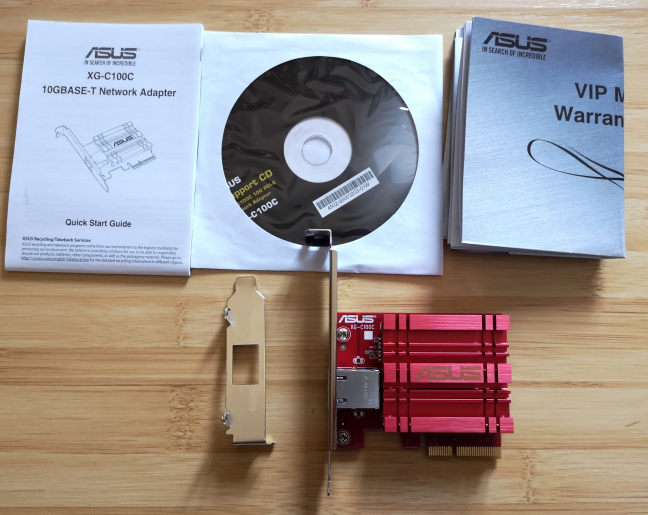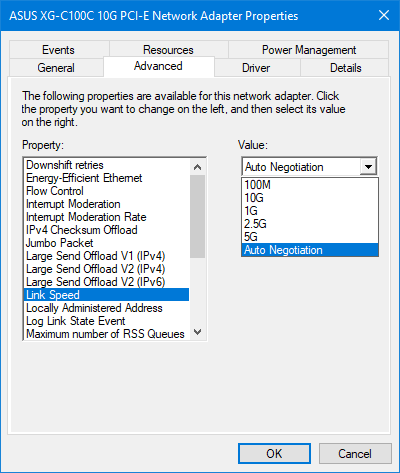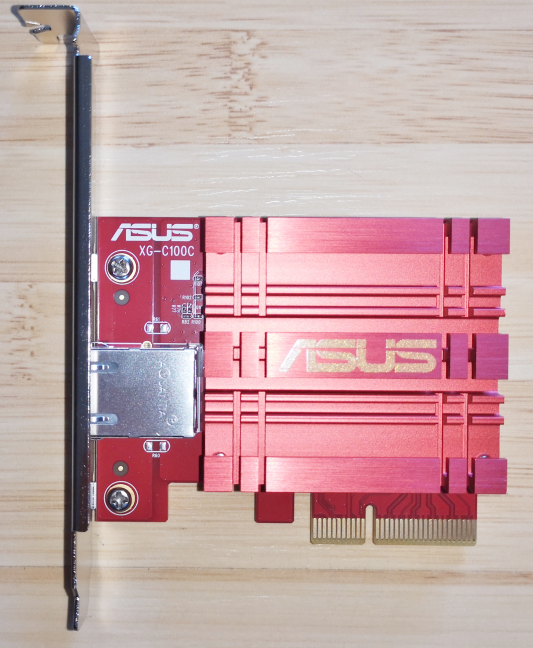
Our team enjoys using 1 Gbps internet connections. For most people in the world, that is fast. However, 10 Gigabit internet connections and devices are starting to show up. Yes, they are mostly for business users, but internet service providers are going to create 10G plans for consumers too. If you were to have such an internet connection, you could download any game from Steam in 5 to 10 seconds. Imagine that! However, if you want to enjoy such network and internet connections, you need this little bugger: the ASUS XG-C100C network adapter. Read this review and see what it has to offer:
ASUS XG-C100C: Who is it good for?
This network card is a good option for:
- People and businesses that have internet connections faster than 1 Gbps
- Users who have routers and networks capable of working at speeds higher than 1 Gbps
- Gamers who desire the fastest network card, with built-in QoS (Quality of Service) for online gaming
Pros and cons
ASUS XG-C100C has many good things going for it:
- It is the fastest Ethernet network card available for consumers
- It supports multiple networking standards and speeds (from 100 Mbps to 10 Gbps)
- It works both on Windows and Linux
- It is easy to install
There are a few downsides too:
- It is more expensive than traditional PCI-Express Ethernet network cards
- Few users benefit from using it, because network and internet connections faster than 1 Gbps are few and far between
Verdict
ASUS XG-C100C is a small beast. It works flawlessly, and it has good driver support, both for Windows and Linux. To make it even more appealing, it comes with a built-in QoS (Quality of Service) that prioritizes online gaming. Right now, this network adapter is an investment in the future. Its value is going to be fulfilled when Wi-Fi 6 wireless routers with 2.5 Gbps or 10 Gbps Ethernet connections become the norm. When writing this review, there are only a few such routers on the market, and all of them are expensive. However, this is going to change in the coming years. We are looking forward to upgrading our internet connection to 2.5 Gbps or 10 Gbps. Only then ASUS XG-C100C can show its value.
Unboxing the ASUS XG-C100C network card
The ASUS XG-C100C 10G network adapter comes in a small box blue/white box. On the top cover, you see a picture of the network card, as well as a list of its essential characteristics.
On the back side of the box, you see detailed information about its compatibility with networking standards, so that you understand whether it is a good fit for your needs.
Inside the box, you find the following elements: the ASUS XG-C100C PCI-Express network card, a disc with drivers and user manuals, information about the warranty, a printed quick start guide, and a spare metal chassis for using the network card in small-format PCs.
The packaging used for the ASUS XG-C100C network card and simple, and easy to unbox. Inside you find everything you need to get started, including a disc with drivers for Windows and Linux.
Hardware specifications
ASUS XG-C100C is a PCI-Express network card that uses an Aquantia AQtion AQC107 high-performance controller, that is capable of handling 10 Gbps Ethernet connections.
The best part about is that it can work with multiple types of Ethernet connections: 100 Mbps, 1 Gigabit, 2.5 Gigabits (like those on the ASUS ROG Rapture GT-AX11000 wireless router), 5 Gigabits, and 10 Gigabits.
You can install ASUS XG-C100C on any computer, as long as it has a PCI-Express port available. It has a small size of 12 x 8.46 x 2.05 inches or 30 x 21 x 5 centimeters in length, width and height, without the bezel. The card also has a spare metal chassis for using the network card in small form factor PCs, which is an excellent precaution on ASUS's part.
ASUS XG-C100C can work with both Cat5e and Cat6 network cables. We used it with a Cat6 cable, connected to a desktop computer.
If you want to read the official specification of this product, go to this page: ASUS XG-C100C Specifications.
Using the ASUS XG-C100C network adapter
Wireless routers that offer 10 Gigabit ports are slowly entering the market, and they are going to become the norm in the coming years, at least on the premium market. Also, 10 Gigabit internet connections are slowly creeping up all over the world. While it may take a few more years until they become commonplace, there are a few countries where you can get such subscriptions, including in the United States, Sweden, or Estonia. While not many people need a network card like ASUS XG-C100C, their number is going to slowly increase in future years.
Now, let's get back to using this powerful network card: installing the ASUS XG-C100C network card is easy. The installation is done like with any other PCI-Express card. As you can see, the network card has a red heatsink with the ASUS logo on it, which cools the Aquantia AQC107 controller that does the heavy lifting.
To use the ASUS XG-C100C network adapter, you need to install its drivers. Luckily, ASUS has provided a disc in the box, that you can use. However, those are the initial version launched by ASUS when the network card was first manufactured. In the meantime, you can find newer drivers that improve performance, on their support page. ASUS provides updated drivers from Windows 7, Windows 8, and Windows 10, as well as Linux, making this card useful also in enterprise environments.
We used the ASUS XG-C100C in conjunction with the ASUS ROG Rapture GT-AX11000 wireless router that has a 2.5 Gbps Ethernet port. The network card worked straight away at that speed, without any configuration on our part.
Unfortunately, we could not test the speed potential of this network card for the following reasons: the router we used had only one 2.5 Gbps port, and our desktop PC was the only one in the network working at this speed. Also, our internet connection is capped at 1 Gbps for the download speed. As you can imagine, ASUS XG-C100C had absolutely no problems to provide us with downloads at 1 Gbps. However, we did a bit of searching online, and we found some discussions, where a few lucky users, were able to test this network card on 10 Gbps connections, and the card delivered as promised. It would have been awesome to receive in testing from ASUS two network cards so that we could create a direct connection between two desktop computers, and see for ourselves that ASUS XG-C100C can achieve its promise of 10 Gbps. We could have transferred the contents of a Blu-Ray disc with Spider-Man: Into the Spider-Verse, in approximately five seconds. 🙂
One neat feature is that ASUS XG-C100C also has built-in Quality-of-Service (QoS) technology that automatically prioritizes bandwidth for gaming packets so that you can enjoy a smooth, latency-free gaming experience. This makes it a good pick for gamers who desire the best possible speed for their online gaming experience. Most probably they are the first niche of consumers that would love using such a network card.
What is your opinion about the ASUS XG-C100C network card?
We loved using the ASUS XG-C100C network card, even though we could not reach its maximum potential. When we have the means to do that, we promise to get back to you, and update this review, and recommend this powerful network card to a broader audience, that can benefit from using it. Until then, do not hesitate to leave a comment and tell us what you think about the ASUS XG-C100C. Also, when do you think that 10 Gigabit internet connections are going to become widespread, even for home users?


 22.03.2019
22.03.2019 












